Effective Fly Foggers for Cattle Management Solutions


Intro
Cattle farming, much like any other agricultural enterprise, is fraught with challenges. Among these, managing livestock pest populations ranks high, especially flies. These pests can impact not only the health and comfort of cattle but also threaten productivity and profitability. Fly foggers have emerged as a vital tool in the arsenal of modern livestock management, allowing farmers to combat these insects efficiently.
Understanding the principles behind fly foggers, along with their applications and benefits, equips cattle farmers with the knowledge required to implement effective pest management strategies. In this guide, we will delve into the essential concepts and techniques associated with fly fogging, focusing on optimal usage and best practices that respect both animal welfare and environmental considerations.
Preface to Fly Foggers in Cattle Management
In the intricate dance of cattle management, one adversary stands out with a persistent presence: insects. The common fly, with its incessant buzzing and propensity to irritate livestock, can wreak havoc if not kept in check. This article delves into a significant piece of the puzzle: fly foggers. These devices are not just tools but crucial assets for farmers and ranchers who strive to maintain both the health and productivity of their herds. Understanding the importance of fly foggers is essential for effective livestock management.
Flies are not mere nuisances; they pose substantial threats to cattle health. When flies swarm, they can cause stress, irritation, and ultimately lead to decreased weight gain and milk production. Furthermore, they are vectors for various diseases that can compromise the well-being of livestock, leading to financial losses for farmers. The need for insect control is paramount, thus making foggers a vital component in the toolkit of cattle management.
Understanding the Need for Insect Control
The necessity for insect control in cattle management is underscored by the direct correlation between fly populations and livestock performance. Flies like the horn fly can multiply rapidly, with a single female laying hundreds of eggs in a short time. Not only do these pests create discomfort, they also lead to increased stress in cattle. A stressed animal is less likely to graze effectively, which can impact overall health and growth rates.
To tackle such issues, farmers often rely on insecticides. However, traditional methods can be labor-intensive and sometimes ineffective. This is where fly foggers come into play. These devices enable a more efficient and automated approach to insect control, allowing for a broader application of insecticides over larger areas, ensuring that flies are effectively managed without unduly disturbing the day-to-day operations of the farm. By using fly foggers, farmers can adopt a proactive approach, significantly reducing fly populations before they dominate the landscape.
Overview of Fly Foggers
Fly foggers are specialized equipment designed to disperse insecticides in a fine mist, targeting insects in a manner that enhances the efficacy of the chemical application. They come in various types, including thermal and cold foggers, each with its advantages depending on the specific needs of the operation.
- Thermal Foggers heat the insecticide into a vapor, which then condenses into small droplets upon contact with the air. This method is particularly effective for covering large areas quickly, making it a favorite among those who manage extensive cattle operations.
- Cold Foggers, on the other hand, utilize a fan to aerosolize the insecticide without heating it. This method has the benefit of being able to apply a more targeted approach, which can be crucial when working near sensitive areas.
The selection of a particular type of fogger typically depends on the specific environment and the scale of application required. Properly deployed fly foggers can significantly reduce the dependency on manual insect control, translating into better health and productivity for livestock. Choosing the right equipment and understanding its function is essential for maximizing benefits and minimizing risks.
"An ounce of prevention is worth a pound of cure." This adage holds true in cattle management, where a strategic approach to fly control can save farmers substantial costs and protect their livestock from undue stress and disease.
Mechanics of Fly Foggers
Understanding the mechanics behind fly foggers is crucial for anyone involved in cattle management. These devices are not just about spraying chemicals; they represent a confluence of engineering and agricultural science that aims to maintain livestock health. Understanding how these machines operate can lead to optimized usage, better outcomes for animal welfare, and increased productivity on the farm. This section will delve into the operational principles of fly foggers and the different fogging techniques available, which are essential in formulating an effective pest management strategy.
How Fly Foggers Operate
Fly foggers function through the principle of aerosol generation, converting liquid insecticides into tiny particles, which can then be dispersed into the air. This method is not just about the mechanics of spraying; it involves a careful understanding of the liquid’s physical properties and the environmental conditions at play.
When a fogger is activated, it utilizes a pump to force the liquid insecticide through a nozzle, where it is vaporized or atomized. The result is a fine mist that hangs in the air and penetrates the cattle’s living environment effectively. This fine particle size is essential because smaller droplets can remain airborne longer, allowing for a more uniform distribution of insecticides, thus enhancing effectiveness.
In the world of insect control, precision is paramount. Foggers allow for targeted applications that minimize waste and reduce the risk of harming beneficial insects and non-target species. Understanding how to operate these machines is an invaluable skill, translating into improved results on the ground.
Types of Fogging Techniques
The effectiveness of fly foggers largely hinges on the specific fogging technique employed. Understanding these different methods helps farmers choose the right approach to meet their needs. The two primary types of fogging techniques are thermal fogging and cold fogging. Each has distinct characteristics and applications.
Thermal Fogging
In thermal fogging, the insecticide is heated in a reservoir, typically to around 200 degrees Fahrenheit. The hot liquid is pushed through the nozzle where it vaporizes and is released as a dense fog.
One of the key characteristics of thermal foggers is their ability to generate a thick, visible fog that can cover large areas quickly. This method is a solid choice when dealing with high insect populations, as the heat can also aid in the quicker evaporation of the solvent used in the insecticide.
However, there are advantages and disadvantages to consider. The primary advantage is the sheer coverage and effectiveness in open areas. Yet, it should be noted that thermal fogging isn’t suitable for all types of insecticides and may require caution to prevent damage to nearby crops or sensitive wildlife.
Cold Fogging
Cold fogging operates on a significantly different principle. Instead of using heat, cold fogging relies on high-pressure pumps to create aerosol droplets at room temperature. This method often utilizes smaller droplet sizes averaging 5 to 30 microns, allowing for more precise targeting without the hefty equipment needed for thermal fogging.
Cold fogging benefits from being less likely to create hazards associated with heat and is often more versatile with the types of chemicals that can be used. This makes it a popular choice among many farmers. However, the unique feature of cold fogging—the ability to penetrate into tight spaces while minimizing drift—comes with its own challenges, such as requiring more frequent applications due to less residual effectiveness compared to thermal fogging.
Application Techniques
The right application techniques are the backbone of effective fly fogging in cattle management. The significance of this topic cannot be overstated; proper application ensures maximum efficacy while safeguarding animal health and the surrounding environment. By utilizing correct techniques, farmers reduce the risk of fly populations taking hold, thus fostering healthier livestock and improved yields in productivity.
Preparation for Fogging
Before the fogging process begins, preparation is essential. Start by assessing the area. Identify hotspots where flies breed, typically moist areas or where cattle congregate. Next, clear any obstacles or materials that could interfere with the fog. This might sound obvious, yet clutter can diminish fog dispersion, and flies could still find refuge in corners or behind structures.
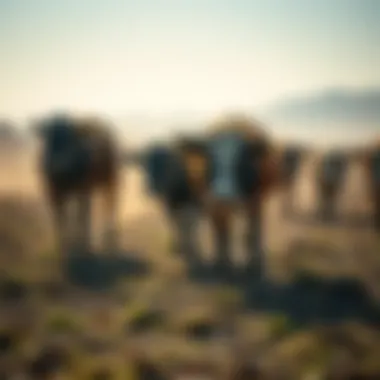
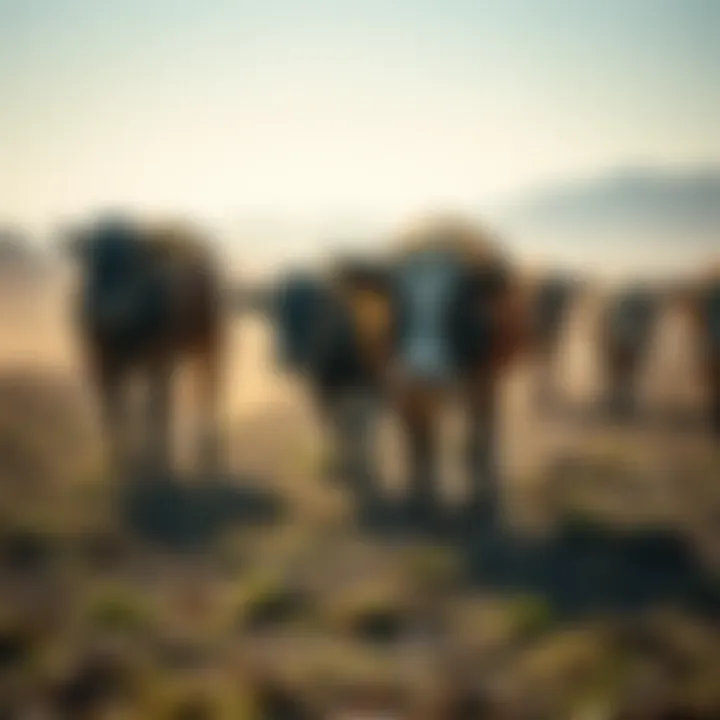
Moreover, choosing the right chemicals is pivotal. Always select insecticides that are effective against the types of flies prevalent in your region, and ensure to follow label instructions for proper dilution. Performing a trial in a small section can also help understand how effective the fogger is under specific conditions.
Timing and Frequency of Application
Timing is another crucial element. Flies tend to be most active during the warm hours of the day, usually between 10 AM and 4 PM. Fogging during these hours increases the chances of catching the little nuisances off-guard, enhancing effectiveness. Conversely, fogging in early morning just before the sun rises can also be beneficial, as this time might allow chemicals to settle and permeate into the areas where flies live.
The frequency of application depends largely on the pesticide selection and the intensity of the fly population. Typically, routine applications every two weeks during peak fly season yield good results. However, periodic evaluations of the fly population should guide adjustments to the schedule.
"Being proactive in timing keeps the upper hand against flies and enhances livestock welfare."
Best Practices for Effective Usage
For fogging to be effective, adhering to best practices is necessary. First, wear suitable protective equipment. This includes gloves, goggles, and masks to protect against any potential chemical exposure. After preparing, ensure that all equipment is well-maintained. Regular checks for leaks or malfunctions can save a lot of headache down the line.
When fogging, angle the nozzle downwards to allow the mist to drift down to the animals and the ground where flies often congregate. Avoid windy conditions since wind can blow the mist away, diminishing its effectiveness. Furthermore, sensitive areas like water bodies or non-target crops must be accounted for, and shielded if needed.
In addition, observing cattle reactions during and after fogging can provide insights into the technique’s effectiveness. Monitoring their comfort level and health because this directly correlates to the effectiveness of the applied treatment. Always document the outcomes for future reference. This due diligence pays off in managing not just flies, but overall livestock welfare.
Benefits of Using Fly Foggers
The significance of employing fly foggers in cattle management cannot be overstated. These devices serve a pivotal role in safeguarding livestock from the debilitating effects of insect infestations. By ensuring a steady defense against pests, farmers find themselves at an advantage, nurturing healthier herds and improving overall productivity. In this section, we'll delve into the multifaceted benefits of using fly foggers, illustrating how they contribute to enhanced livestock health, increased productivity, and cost-effectiveness in pest control.
Improved Livestock Health
Insects pose a considerable threat to livestock, causing not only irritation but also the potential for serious health issues. These nuisances can transmit diseases, which may lead to significant drops in milk production or weight gain. By utilizing fly foggers, farmers can effectively minimize insect populations, thereby creating a healthier living environment for cattle.
Consider the case of a dairy farm in Wisconsin where regular fogging reduced the fly population by over seventy percent. Farmers noticed a marked improvement in their herd's overall well-being, with fewer cases of mastitis and a healthier rate of growth for calves. This not only benefits the animals but gives farmers peace of mind knowing they are taking proactive measures for their livestock's health.
Enhanced Productivity
When livestock is comfortable and free from the harassment of flies and other pests, productivity flourishes. The productivity of cattle, whether in terms of milk or meat, directly correlates with their well-being. The reduced stress from insect bites allows animals to feed better and engage in more natural behaviors.
For example, research indicates that farms employing fly foggers see up to a fifteen percent increase in milk yield during peak fly seasons. This spike is not merely a fluke; it is a logical outcome of a pest-free environment. Additionally, less stress translates into better reproductive performance among cattle, which is a vital component for maintaining an efficient breeding program.
Cost-Effectiveness of Fogging Solutions
Investing in fly foggers can initially appear daunting from a budgetary perspective. However, the long-term savings can be substantial. Fogging minimizes losses related to disease outbreaks and impaired milk production, making it a prudent investment in the long run. Here are some key factors to consider:
- Reduction in Veterinarian Costs: By preventing pest-related health issues, farmers can avoid increased veterinary bills.
- Higher Returns on Investment: As mentioned earlier, improved productivity translates directly into enhanced profits.
- Longevity of the Fogging Equipment: While the initial cost may be considerable, proper maintenance can extend the life of fogging equipment, providing ongoing benefits.
"Investing in fly foggers leads to healthier livestock, greater productivity, and notable cost savings, establishing a foundation for a sustainable farming operation."
- Improved livestock health through effective pest control.
- Enhanced productivity by creating a comfortable environment for cattle.
- Cost-effectiveness becomes apparent in reduced health-related expenses and increased overall farm yields.
Going forward, we will explore safety and environmental considerations regarding fly fogging to ensure that these benefits are realized responsibly.
Safety and Environmental Considerations
In the realm of cattle management, particularly when using fly foggers, consideration for safety and the environment is paramount. These factors influence not only the health of livestock but also the surrounding ecosystem. Utilizing chemical control methods, such as fogging, requires a delicate balance between effective pest management and adhering to safety protocols to protect humans, animals, and beneficial organisms.
Chemical Safety Protocols
When handling chemicals for fogging, it’s crucial to keep safety protocols at the forefront. This not only mitigates risk to farm operators but also ensures compliance with safety regulations. Here are some critical protocols to follow:
- Proper training: Ensure that anyone involved in the application of chemicals has received adequate training. They should understand the correct usage, potential hazards, and emergency procedures.
- Personal protective equipment (PPE): Operators should wear gloves, masks, goggles, and protective clothing to shield themselves from harmful chemicals. This equipment is essential in preventing skin contact and inhalation of vapors.
- Storage and disposal: Store chemicals in clearly labeled containers, away from livestock feed and water sources. Dispose of empty or unused chemicals according to local regulations to minimize environmental impact.
- Emergency protocols: Develop and display emergency procedures in case of accidental exposure. This should include immediate steps to take, such as rinsing affected areas or seeking medical assistance.
Adhering to these protocols ensures a safer working environment while optimizing the effectiveness of pest control methods.
Impact on Non-Target Species
The use of fly foggers can have unintended effects on non-target species, highlighting the importance of mindful pest control. Adequate precautions help to protect beneficial pollinators and natural pest predators. Consider the following aspects:
- Degradation of biodiversity: Excessive use of chemical foggers can lead to a decline in insect populations that play key roles in the ecosystem. This includes pollinators like bees, which are vital for the pollination of crops.
- Habitat disruption: Chemicals that drift beyond the intended treatment area may harm nearby vegetation and aquatic systems. Vigilant wind direction monitoring and application timing can reduce this risk.
- Alternatives for pest control: Consider integrating non-chemical methods, such as traps or biological controls, to manage insect populations without harming the environment. The adoption of such strategies can lessen the pressure on non-target species.
Effective pest management doesn’t solely focus on killing insects; it emphasizes coexistence with the ecosystem.
In summary, addressing safety and environmental considerations when using fly foggers is not just a regulatory requirement but a best practice. By ensuring the protection of human health, livestock, and the environment, cattle farmers can implement more sustainable pest management strategies.
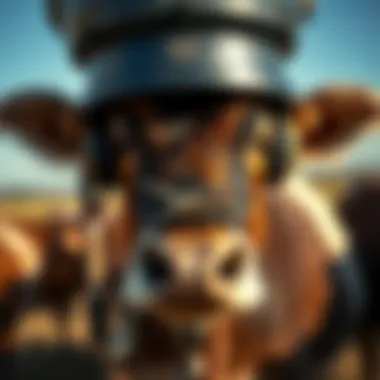
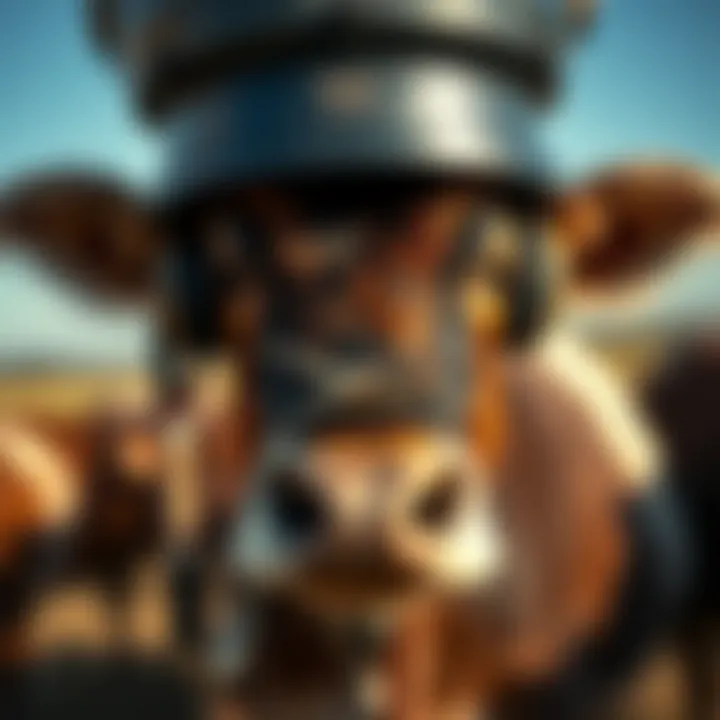
Choosing the Right Fly Fogger
Selecting an appropriate fly fogger can be the difference between a thriving cattle operation and one plagued by disturbances from pesky insects. With farmers always on the lookout for effective pest control methods, it becomes crucial to consider specific features that enhance efficiency and user experience. Understanding the range of options available can also help in making an informed choice, ultimately leading to better livestock health and productivity.
Evaluating Product Features
Nozzle Design
The nozzle design of a fly fogger plays a pivotal role in achieving optimal insecticide distribution. A well-designed nozzle can create a fine mist capable of covering a broader area while minimizing chemical wastage. The key characteristic to note here is the shape and size of the nozzle opening, which greatly influences droplet size. Higher efficacy in pest control often correlates with smaller droplet sizes since they tend to linger longer in the air and reach hard-to-access areas.
However, one should also be wary of the potential downsides. Some nozzles, particularly those that are overly fine, could lead to drift, causing the chemicals to dissipate beyond the target area. Therefore, striking the right balance is critical. It’s advisable to opt for a nozzle that offers versatility, allowing users to adjust settings based on the pest pressure and environmental conditions.
Tank Capacity
Tank capacity is another essential feature that should not be overlooked when choosing a fly fogger. A larger tank can mean fewer refills during operation, allowing for extended use without interruptions. This is especially beneficial on larger farms where time is of the essence, and the last thing you’d want is to be constantly stopping to refill.
On the flip side, larger tanks can increase the overall weight of the fogger, making it less portable. For smaller operations, a heavy fogger could be more of a hindrance than a help. Additionally, tank materials can vary, with some being more resilient to corrosion than others. Therefore, while a higher capacity tank can be advantageous, consideration must also be given to the ease of use and maintenance.
User Reviews and Recommendations
As with any investment, tapping into user experiences can provide valuable insight. Reviews can reveal recurring themes regarding performance, durability, and ease of maintenance, which may not always be evident through specifications alone.
Consider looking for foggers that have garnered positive feedback regarding their operational efficiency and versatility. Many seasoned farmers find it beneficial to engage in forums such as Reddit, where candid discussions about equipment can offer unvarnished opinions. Engaging with peers or joining local agricultural groups on Facebook can also yield recommendations that align with specific regional challenges.
Regulatory Standards and Compliance
In the realm of cattle management, particularly when it comes to managing pesky flies through fogging techniques, compliance with regulatory standards is not merely a formality; it’s a vital cog in the wheel of effective and ethical weed and pest management. Understanding the local and national regulations surrounding the use of fly foggers can significantly influence not only the health of the livestock but also the productivity of cattle operations.
These regulations are often designed with the intent to protect livestock, farmers, and the environment by ensuring responsible usage of pesticides and pest control methods. Ignorance of these guidelines can lead to legal repercussions, financial penalties, or even hazardous conditions for animals and people alike. Thus, familiarity with these constructs isn’t just recommended; it’s essential.
“Compliance is not just about following the rules; it’s about safeguarding your livelihood and that of future generations.”
Understanding Local and National Regulations
Local and national regulations regarding pest control, particularly fly foggers, can differ vastly depending on the state or region. These laws often include restrictions on specific chemicals, application times, and methods of dispensing. For example, while one area may permit certain active ingredients in pesticide formulations, others may strictly prohibit them due to environmental or health concerns.
Farmers must stay abreast of these regulations which may encompass:
- Label Restrictions: Always read the label on any pesticide product carefully. It contains essential information like the areas and types of livestock it can be used on.
- State-Based Requirements: Each state may have its own Department of Agriculture providing guidelines for use and safety protocols, which may impose additional regulations beyond federal standards.
- Permitting Systems: In some jurisdictions, operating a fly fogger may necessitate a permit or license, requiring farmers to demonstrate their knowledge of safe application methods.
Regular reviews on websites of government bodies like USDA.gov or your local Department of Agriculture will offer clarity and keep you informed about new changes in the laws that may affect your operations.
Documentation and Record Keeping
Efficient documentation and record-keeping play a pivotal role in maintaining regulatory compliance. In agricultural practice, having a well-organized record of all pest management activities is crucial not only for compliance but also for enhancing operational efficiencies. Detailed logs can be of immense value in case of audits or inspections.
Farmers should consider documenting:
- Product Usage: Keep records of what products were used, where, and when. It pays to note down details such as batch numbers and dates of application.
- Employee Training: If employees are involved in the fogging process, keeping records of their training related to chemical handling and safety practices is essential. This can help clarify areas of responsibility and liability in case of any issues.
- Health Monitoring: Maintain logs on the health and welfare of livestock post-fogging applications. This can provide feedback on the efficacy of the methods used and help make informed decisions moving forward.
To summarize, understanding and adhering to regulatory standards while keeping meticulous records can significantly benefit cattle management. This approach not only promotes the health of livestock but also aligns with sustainable agricultural practices, setting a solid foundation for responsible farming.
Alternative Pest Control Methods
The management of insect pests in cattle farming entails a nuanced approach, one that extends beyond the mere application of fly foggers. By considering alternative pest control methods, farmers can effectively safeguard the health and productivity of their herds. These strategies not only complement fogging but can also contribute to sustainable agricultural practices. Understanding these alternatives is essential for a holistic pest management program that minimizes reliance on chemicals while improving outcomes for both the animals and the environment.
Biological Control Options
Biological control relies on natural predators or pathogens to manage pest populations. This eco-friendly approach embraces the idea of utilizing existing ecosystems to maintain a balance among species. A farmer might look into introducing species like ladybugs or certain wasps, which can help keep herbivore pests like aphids and caterpillars in check. This method has several benefits:
- Low Environmental Impact: Biological controls reduce the need for synthetic chemicals, leading to healthier pastures.
- Sustainability: By fostering a diverse ecosystem, farmers can contribute to soil health and biodiversity, creating a more resilient landscape.
- Cost-Effectiveness: Once established, natural predators often require less ongoing investment compared to chemical alternatives.
However, there are considerations as well. Introducing non-native species can sometimes lead to unintended consequences, such as invasive behaviors. Local research institutions can be valuable resources for guidance on suitable predators for specific pests. Moreover, farmers should ensure that their biological control methods align with local biodiversity and agricultural policies. For more information on biological pest control, resources like the University of California's Agriculture and Natural Resources can be enlightening.
Integrated Pest Management Strategies
Integrated Pest Management (IPM) adopts a comprehensive framework that blends various pest control techniques, emphasizing prevention. It is not merely a one-size-fits-all solution but a tailored approach that adapts to the specific conditions of each farm. The key components of IPM include:
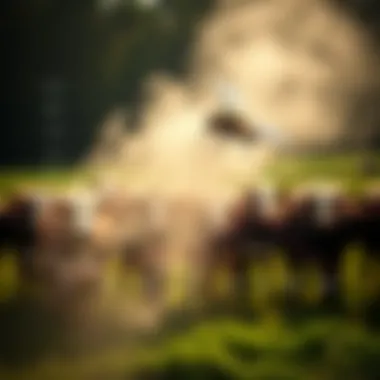

- Monitoring and Identification: Regular inspections help identify pest populations early. This step is crucial to ensure that any interventions are proportionate to the pest problem.
- Threshold Setting: Determining action thresholds allows farmers to decide when intervention is necessary, thereby avoiding unnecessary applications of pesticides or other treatments.
- Cultural Controls: Implementing practices like crop rotation, modifying grazing patterns, and maintaining soil health can disrupt pest life cycles in ways that reduce their numbers without the need for chemicals.
- Chemical Controls: When necessary, select targeted pesticides that have a minimal impact on non-target organisms.
Implementing IPM does require some level of expertise and observation, but the potential for long-term cost savings and enhanced ecosystem health makes it worthwhile. There are numerous guides online that provide frameworks for developing IPM strategies tailored to specific problems in cattle management; you can access the Environmental Protection Agency for educational resources.
"A successful pest management strategy doesn't depend solely on insecticides. Instead, it is a symbiosis of various methods that consider the local ecosystem."
Case Studies: Successful Use of Fly Foggers
The integration of fly foggers in cattle management is not just a theoretical exercise—it's a practice backed by real-world examples. Case studies shed light on the practical applications and successes of these fogging systems across various farms, allowing farmers to glean insight into effective methods that have yielded positive outcomes. Real-life examples serve to reinforce best practices and demonstrate the tangible benefits of these systems, particularly in improving livestock health and farm productivity.
Regional Applications Across Farms
In diverse geographical landscapes, the utilization of fly foggers varies significantly due to the specific insect challenges and environmental conditions faced by individual farms. For instance, a cattle ranch in the humid regions of Georgia has introduced a systematic fogging schedule that aligns with peak insect activity. This proactive approach has drastically reduced the population of pesky biting flies, which are notorious carriers of diseases detrimental to livestock, such as anaplasmosis and pink eye.
In contrast, a dairy farm in the arid climates of California has adapted its fly management strategy to complement the local ecosystem. Here, fogging is not just about the insects; it also considers non-target species to mitigate environmental impact. They deploy foggers equipped with precision nozzles that target specific areas without contaminating nearby water sources. The careful planning has resulted in significant reductions in fly populations and improved milk production rates.
Analyzing Efficacy and Results
Assessing the efficacy of fly foggers involves more than looking at immediate results; it demands a thorough analysis of long-term impacts on livestock health and farm economics. A case study from a beef cattle operation in Texas utilized foggers over a two-year span, meticulously documenting decline in fly numbers and its correlation with cattle weight gain.
"A reduction in fly populations often corresponds with healthier cattle, which leads to better weight gain and lower veterinary costs."
These findings illustrated not only a marked decrease in irritability among the cattle but also increased daily average weight gains by approximately 20% over the summer months. Such figures underscore the necessity to invest in effective fogging solutions.
Moreover, by comparing pre- and post-application data, farms can identify trends in animal health and productivity directly tied to their fly control strategies. For example, records revealed a 30% drop in veterinary visits linked to insect-related issues after implementing regular fogging. The cost savings were notably significant, making a solid case for investing in quality fogging systems.
As farmers continue to share their experiences and outcomes through such case studies, new entrants to cattle management can equip themselves with the knowledge that helps avoid pitfalls and leverage successful strategies from seasoned practitioners.
Future Trends in Fly Control for Cattle
In the ever-evolving landscape of agriculture, staying ahead of the curve is not merely an aspiration but a necessity. The topic of future trends in fly control for cattle management uncovers critical insights that can enhance not just livestock health but overall farm productivity. As cattle farmers face increasing challenges from pests, it becomes imperative to explore innovative solutions that can mitigate these issues effectively and sustainably. This section delves into recent advancements in technology and practices, spotlighting how they are reshaping pest management in the cattle industry.
Innovations in Fogging Technology
The world of fogging technology is experiencing an exhilarating transformation, driven by breakthroughs in engineering and scientific research. One noteworthy trend is the development of automated fogging systems. These systems allow for precise application of insecticides, reducing waste and enhancing effectiveness. Sensor technology has come into play, enabling farmers to target specific areas where insect populations are most dense rather than blanketing entire fields.
Additionally, advancements in formulation technology have led to the creation of environmentally friendly insecticides that are just as efficacious as their traditional counterparts but carry lower toxicity risks. This means that farmers can protect their cattle without compromising soil health or harming beneficial insects. As the demand for sustainable practices grows, these innovations could represent a significant leap forward for the industry.
Potentially beneficial technologies might include:
- Drone-assisted fogging that can cover vast areas quickly and efficiently
- Mobile apps that provide real-time data analysis on pest activity and weather conditions, assisting farmers in optimizing their fogging schedules.
Ultimately, these innovations not only promise enhanced efficacy but also reflect a broader trend towards increasing transparency and accountability in pest management practices.
Sustainable Approaches to Pest Management
Turning to sustainability, it’s essential to recognize that the future of fly control isn’t solely about technological advancements; it also revolves around adopting holistic management strategies. Integrated Pest Management (IPM) is at the forefront of these efforts, combining various strategies that complement one another. For instance, this method integrates biological controls, such as introducing natural predators of flies, while also considering cultural practices like rotational grazing.
As climate change continues to pose challenges, farmers are being encouraged to explore the possibility of regenerative agriculture principles. This could involve practices such as:
- Soil health improvements to create a robust ecosystem that can naturally resist pest outbreaks
- Using cover crops that attract beneficial insects which feed on pests
By adopting sustainable methods, farmers not only enhance their resistance against pests but also build long-term resilience into their farming practices.
Innovations and sustainable practices represent a dual approach in fly control, paving the way for a healthier agriculture ecosystem while securing the future of cattle management.
Finale
As we draw the curtains on this comprehensive guide, it’s crucial to underscore the significance of effective pest management in cattle operations. Fly foggers emerge not just as a tool but as a vital ally in the pursuit of livestock welfare and productivity. These devices not only mitigate insect populations but also lay the groundwork for healthier herds. In essence, the practical insights gathered here highlight that investing in the right fly control solution is not merely an option; it’s a necessity for farmers eager to optimize their yields and safeguard their livestock’s health.
Recap of Key Insights
Throughout this exploration, several key insights have emerged:
- Mechanics of Operation: Understanding how fly foggers operate underpins their effectiveness. Thermal and cold fogging techniques each serve distinct purposes, targeting various environments and insect types.
- Application Techniques: The timing and frequency of applications can significantly impact outcomes. Tailoring these practices to specific environmental conditions maximizes benefits.
- Safety and Environmental Considerations: Safe handling protocols for chemicals, alongside awareness of non-target species, can help maintain ecological balance.
- Benefits of Fly Foggers: These tools bolster livestock health, enhance productivity, and prove cost-effective in the long run.
"A wise farmer knows that without proper insect control, productivity can dwindle, leading to potential losses."
Call to Responsible Practice
Discussions surrounding fly foggers frequently touch upon efficacy and cost but should also embrace a broader ethical narrative. Farmers must prioritize responsible practices. This involves understanding local regulations, keeping meticulous records, and ensuring adherence to chemical safety protocols. Furthermore, integrating foggers into a holistic pest management strategy—rather than relying solely on them—can play a pivotal role. Using complementary methods, such as biological controls or integrated pest management strategies, not only expands options but demonstrates a commitment to sustainable agriculture.
Ultimately, the path to effective cattle management lies not just in the tools wielded but in the intent behind their application. By cultivating responsibility alongside innovation, farmers can help secure a prosperous future for the agricultural landscape.















